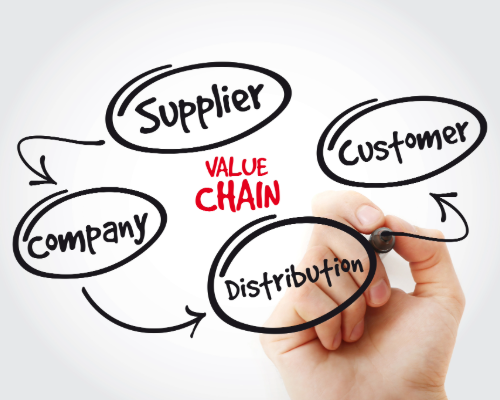Table of contents
- Key Takeaways
- Deciphering the Analytical Value Chain
- Crafting a Competitive Strategy with Value Chain Analysis
- The Intersection of Value Chain and Supply Chain Management
- Implementing Value Chain Management for Superior Performance
- Measuring Success: Key Performance Indicators (KPIs) in Value Chain Analysis
- Harnessing Analytical Tools for Value Chain Insights
- Case Studies: Transformative Impact of Analytical Value Chains
- Summary
- Frequently Asked Questions
- What is the primary goal of value chain analysis?
- How does value chain analysis differ from supply chain management?
- Can value chain analysis lead to cost reduction?
- What role does technology play in value chain management?
- Why are customer loyalty and retention metrics important in value chain analysis?
Delving into the analytical value chain is key for businesses aiming to streamline operations and outperform competitors. This article cuts through complexities to explain how segmenting and analyzing each business activity paves the way for strategic improvement and sustained market advantage. Discover the actionable steps to transform your company’s performance.
Key Takeaways
-
The analytical value chain enables businesses to evaluate their primary and support activities, focusing on strategic optimization to enhance customer value and gain a competitive edge.
-
Value chain analysis is pivotal for crafting competitive strategies by identifying cost reduction, differentiation, and quality control opportunities to improve efficiency, customer acquisition, and profitability.
-
Implementing effective value chain management involves continuous innovation and integration of technology. This helps streamline operations, improve product and service quality, and maintain superior performance and customer satisfaction.
Deciphering the Analytical Value Chain

At the heart of any successful business lies its ability to provide value to its customers. But how much value does a business truly offer? This question is at the core of the value chain concept, introduced by Harvard Business School professor Michael Porter in 1985. The analytical value chain scrutinizes a business’s activities, from procuring raw materials to the final handshake with the customer, aiming to enhance every touchpoint to perfection.
This chain analysis matters because it provides a comprehensive framework for conducting a value chain assessment. It breaks down complex business operations into digestible, manageable components. It categorizes activities into primary and support functions, allowing companies to pinpoint areas for strategic optimization and thereby secure a stronger competitive advantage within the market.
We shall explore further these key components and their contributions to a successful value chain.
Understanding Primary Activities in Detail
The foundational elements of a business’s operations, known as primary activities, create an essential sequence that directly impacts the production and provision of goods and services. These crucial activities encompass:
-
Inbound logistics: This phase involves acquiring and receiving the necessary raw materials for manufacturing.
-
Operations: Those materials are effectively converted into the finished product at this stage.
-
Outbound logistics: This finalizes this imperative section of the value chain by ensuring products reach their end consumers.
Sales and marketing efforts act as the frontline representation of these primary activities. Here, a company conveys its value proposition to its audience while establishing and nurturing customer relations. It’s through the effective execution of these chain activities that businesses enhance customer value and satisfaction. Meticulous management at every juncture is required so businesses don’t just meet but surpass consumer expectations with their final product offerings.
The Role of Support Activities
While the primary activities play a crucial role in creating value, they are greatly enhanced by the underlying combination of primary and support activities. These foundational elements form the backbone of the value chain and include aspects such as:
-
procurement,
-
technology development,
-
human resource management,
-
firm infrastructure.
By integrating technology into their business frameworks, companies can significantly improve operational efficiency and foster product design and creation innovation.
Human resource management is instrumental because investing in staff expertise and performance profoundly boosts cost savings while cementing an increased competitive advantage. Although these supportive actions might not be immediately apparent to consumers, they’re indispensable for ensuring that primary activities operate seamlessly and evolve continually, thereby enriching customer value.
Crafting a Competitive Strategy with Value Chain Analysis

Value chain analysis is a critical tool for navigating the complexities of competitive strategy. It enables businesses to meticulously examine their internal operations, identify avenues to cut costs, enhance processes, and create distinctiveness in the market—all key factors for securing a competitive advantage. This kind of analysis not only strengthens support for sales efforts but also fosters operational efficiency, profit growth, customer base expansion, and error minimization.
Value chain management necessitates a comprehensive overhaul of various organizational systems and procedures to optimize performance and preserve the caliber of services or products offered to consumers. Vigilant observation and constant refinement are imperative as part of strategic business practices that are sustained over time. This ensures that the company’s competitive approach continues to align with evolving market demands while remaining robust against future challenges.
Identifying Cost Drivers and Quality Control Mechanisms
Value chain analysis is a strategic tool that harmonizes cost reduction with maintaining high standards of quality. It involves breaking down an organization’s expenses to identify the main factors contributing to costs, allowing companies to address and improve upon these inefficiencies. The goal isn’t merely trimming small amounts but enhancing the entire production process to deliver higher value at a more attractive cost.
Within this framework, quality control systems are crucial elements. By recognizing what customers prioritize—from swift transaction processing to staff expertise—companies can direct their efforts toward managing expenses and ensuring product excellence. Through such insights gained from value chain analysis, businesses can lower overall expenditures while positioning their offerings as more affordable or feature-rich than competitors’.
Achieving Product or Service Excellence
Striving for product or service excellence starts with concentrating on the value chain activities most valued by customers. Distinguishing those activities is vital for achieving a differentiation advantage that can lead to increased profit margins. Benchmarking company activities against competitors is critical in this process, as it identifies areas ripe for improvement and innovation.
To elevate the value offering, businesses can concentrate on:
-
Enhancing customer service
-
Personalizing products
-
Offering incentives
-
Adding unique features that set them apart
This leads to customer loyalty and allows companies to command a premium price for their superior product or service.
Excellence, therefore, is not just a standard to be achieved but an ongoing commitment to sustaining superior performance, exceeding customer expectations, and consistently delivering value.
The Intersection of Value Chain and Supply Chain Management

Understanding the intricate link between value chain analysis and supply chain management is crucial for companies striving to thrive in today’s competitive marketplace. Value chain analysis explores the internal processes of creating value while considering how external networks, including sourcing and distribution within the supply chain, contribute from start to finish. The goal of managing the supply chain is centered on improving operational efficiency and ensuring dependability at every step, from procurement to product delivery.
On a higher level than mere logistics or production, executing a strategy based on value chains focuses on enhancing customer satisfaction and forging competitive advantage by meticulously shaping each point of interaction with customers through touchpoints that include innovation and service. This strategic approach encompasses marketing initiatives and consumer insights research, which lie outside straightforward manufacturing or shipping processes but are integral in augmenting a product’s life cycle success. It becomes clear then that aligning both values and supply chain strategies is indispensable when it comes to achieving comprehensive effectiveness coupled with surpassing customer expectations.
Implementing Value Chain Management for Superior Performance

Implementing value chain management is a strategic move that transforms an organization’s systems, structures, and procedures. Companies strive to minimize mistakes and achieve outstanding performance by systematically evaluating and enhancing operations. Seamless product delivery depends on effective collaboration between leaders who oversee various value chain segments.
Applying templates for value chain analysis helps identify areas where efficiency can be improved, enabling businesses to refine their processes accordingly. This effort leads to superior products being produced at reduced costs—propagating business expansion while also increasing customer recognition of the improvements made. It represents an ongoing pursuit of exceptional performance, which ultimately yields rewards for increased customer satisfaction and fidelity.
Technology Development and Integration
In response to evolving market conditions and consumer patterns, the integration of technology into various stages of the value chain is becoming increasingly critical. By adopting technological advancements, companies can nimbly adjust their supply chains to meet fluctuating demands, enhancing operational efficiency and driving profitability. Digital tools also play a pivotal role in ensuring that organizations maintain consistent internal processes across different regions globally.
Employing technology within the realm of value chain activities offers a competitive edge through differentiation. Businesses are empowered to distinguish themselves by providing novel capabilities and services via technological innovations such as sophisticated inventory management solutions or AI-enhanced customer support systems. This strategic application of technology not only augments the effectiveness but also elevates both quality throughout chain activities and supports standout product features—culminating in exceptional performance and distinct product offerings.
Firm Infrastructure Optimization
The company infrastructure, encompassing the organizational structure and administrative processes, establishes a supportive foundation for the value chain. Enhancing efficiency in this realm is targeted at elevating primary activities such as planning, accounting, finance, and quality control.
In consequence of these improvements lies an enhancement in customer-facing operations that are integral to the enterprise’s competitive strategy.
Refining the firm infrastructure enables organizations to achieve cost savings while enhancing communication effectiveness and simplifying governance procedures. This streamlining begets a cost advantage whilst cementing a long-term competitive edge. The culmination is an organization functioning with high precision. Every aspect of its value chain synchronizes seamlessly to amplify excellence which bolsters profit margins significantly.
Measuring Success: Key Performance Indicators (KPIs) in Value Chain Analysis
The real measure of an effectively implemented value chain is evident through its performance indicators. Key performance indicators (KPIs) act as navigational tools that steer companies toward continual enhancement and strategic adjustment. These indicators thoroughly assess all segments of the value chain activities, yielding insights into various metrics such as:
-
Turnover rates
-
Revenue generation
-
Market demand fluctuations
-
Expenditure levels
-
Efficiency in processes
-
Stakeholder relationships
By consistently monitoring and evaluating KPIs, organizations can pinpoint both their triumphs and areas requiring improvement. This perpetual loop of feedback proves critical for devising strategies that not only advance the company but also maintain a flexible and robust value chain capable of withstanding shifts within the market landscape.
Customer Loyalty and Retention Metrics
A company’s health is often measured by how well it retains and earns the loyalty of its customers. Metrics that capture customer satisfaction and order accuracy are a testament to the successful execution of value chain activities. By integrating direct feedback from customers into their data analysis, companies can refine their firm infrastructure so it resonates more effectively with the needs and preferences of their target market.
Harrah’s Entertainment Inc.’s experience highlights the importance of tracking customer metrics in business success. The adoption of Customer Relationship Management (CRM) strategies enabled Harrah’s to gain insights into consumer behavior, leading to increased loyalty and improved financial performance. These kinds of metrics serve as both an indicator for current standing in terms of service quality while also providing predictions about future profitability based on how valued and satisfied customers feel towards a brand.
Inventory Turnover and Cost Savings Indicators
Optimizing inventory management is crucial within the value chain as it directly influences both cost effectiveness and customer satisfaction. Metrics like Inventory Turnover shed light on the rate at which stock is sold and restocked, reflecting how well a company can fulfill orders and maintain sales momentum. Additional measures such as Days on Hand (DOH) and Inventory Days of Supply are essential for understanding how long items stay in storage, allowing firms to fine-tune their stocking schedules while minimizing associated holding costs.
By tracking Inventory Velocity, companies can predict what portion of their inventory will be sold during an upcoming timeframe. This insight enables organizations to:
-
Align their inventory quantities with actual market demands
-
Refine methods for handling stock levels
-
Diminish expenses linked to excess supplies
-
Minimize unnecessary waste
-
Bolster profit margins
Employing these metrics offers valuable leverage for enhancing practices around managing inventories effectively.
Harnessing Analytical Tools for Value Chain Insights

In today’s digital era, businesses seeking profound insights into their value chain find analytical tools to be invaluable. Platforms like Miro’s Value Stream Mapping optimize process efficiencies within value delivery, offering a modern twist to Porter’s classic model. Similarly, software such as EdrawMax, with its user-friendly interface and extensive template library, empowers companies to create comprehensive value chain diagrams.
These tools enable real-time collaboration, allowing teams to share feedback and expedite project completion. Furthermore, AI-powered features assist in brainstorming and strategizing during the analysis, ensuring that businesses can quickly identify opportunities for improvement and act on them effectively.
Utilizing a Chain Analysis Template
Templates revolutionize the process for businesses aiming to carry out a systematic value chain analysis. Available freely online, these templates provide a structured approach to dissecting and understanding the value chain framework. By mapping out each activity, companies can visualize inefficiencies and pinpoint areas that require enhancement or innovation.
Utilizing a chain analysis template offers several benefits.
-
It serves as a strategic instrument that turns intricate business operations into actionable insights.
-
It lays the groundwork for process optimization.
-
It helps businesses remain agile in a competitive marketplace.
-
With the right template, the process of conducting a value chain analysis becomes not only manageable but also an insightful journey towards business excellence.
Case Studies: Transformative Impact of Analytical Value Chains
The practical effectiveness of a well-executed value chain is firmly established, with many companies harnessing its benefits to their advantage. Take Starbucks as an example. The company has revolutionized the coffee experience on a global scale through precise management of every aspect of their operation. The key components that have shaped their exceptional value chain include:
-
Acquiring coffee beans
-
The process of roasting and blending them
-
Design and atmosphere within stores
-
Training for employees coupled with superior customer service
Concentrating on each segment within the value chain allows Starbucks to ensure consistency and quality in serving its customers.
Li & Fung Limited exemplifies masterful manipulation over extensive international supply chains, expertly navigating relationships with multitudes of suppliers to furnish top-notch goods for retailers and brands alike. McDonald’s efforts in crafting a strong local supply network within India stands as evidence—highlighting both obstacles surmounted and achievements earned—in securing ingredients like French fries.
Esquel Group garners praise in textile production due to trailblazing strategies it employs while Zappos resets expectations for online shopping via its emphasis on variety and dedication to consumer satisfaction—all underscoring how critical a solidified value chain is in realizing commercial triumphs.
Summary
In concluding our journey, it becomes clear that value chain analysis transcends a mere business instrument. It embodies an all-encompassing approach blending every facet of operational execution to amplify the value delivered to customers. By meticulously examining both primary and support activities and smartly deploying KPIs along with technological advancements, chain analysis serves as the pivotal foundation for contemporary corporate efficacy. Fueled by its demonstrated transformative effects in various case studies, we recognize that the analytical value chain pulsates at the core of any enterprise’s pursuit of excellence.
Frequently Asked Questions
What is the primary goal of value chain analysis?
Value chain analysis focuses on scrutinizing and refining the entirety of a business’s activities, with the principal aim being to streamline operations, diminish wastage, and boost customer value through optimization of the complete value chain.
How does value chain analysis differ from supply chain management?
Chain analysis in the context of a value chain emphasizes examining each step along the customer’s path to improve their experience and achieve competitive advantage, contrasting with supply chain management which is dedicated to streamlining processes from procurement through distribution.
Can value chain analysis lead to cost reduction?
Certainly, conducting a value chain analysis can facilitate cost savings by pinpointing areas of inefficiency and key cost drivers in company operations. By instituting quality control mechanisms, it’s possible to curb expenses while still preserving the value delivered to customers.
What role does technology play in value chain management?
In modern business operations, technology serves as a pivotal element in managing the value chain. It bolsters efficiency in processes, responds to evolving customer needs, maintains uniformity across internal procedures, and aids in distinguishing products, which leads to superior performance. Technology is undeniably an essential ingredient for success within value chain management.
Why are customer loyalty and retention metrics important in value chain analysis?
In the process of conducting value chain analysis, it is crucial to factor in metrics related to customer loyalty and retention since they provide essential insights into how well customers’ needs are being met. This directly influences profit margins as well as the likelihood of sustained business success.
Such metrics incorporate evaluations of customer satisfaction and rates at which perfect orders are fulfilled, all integral components within a comprehensive value chain analysis.


